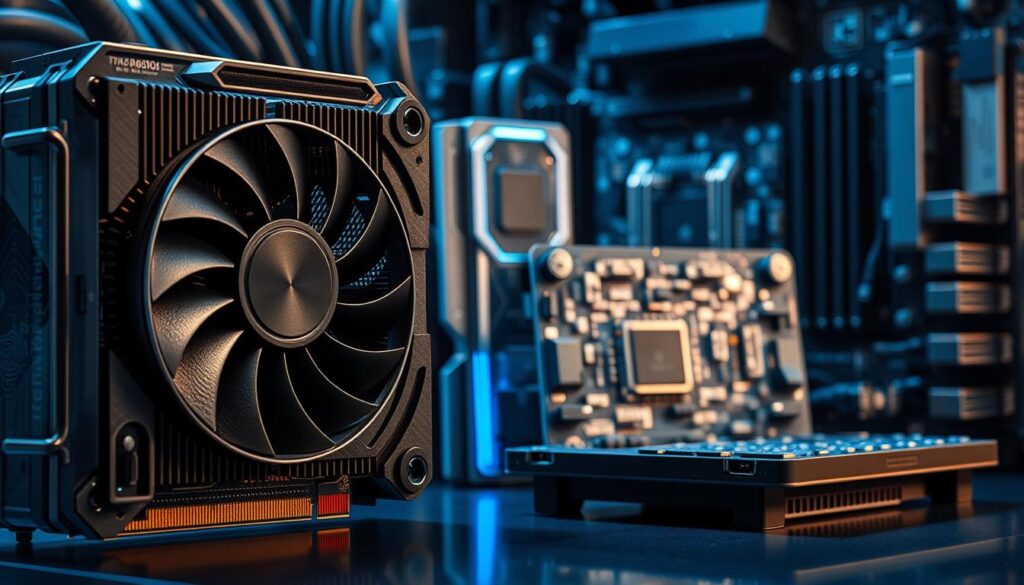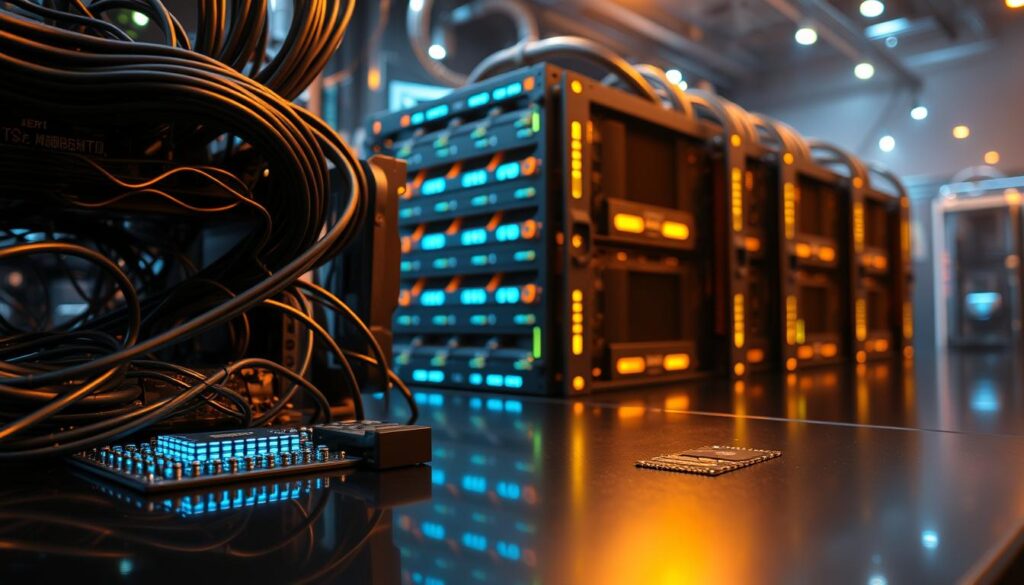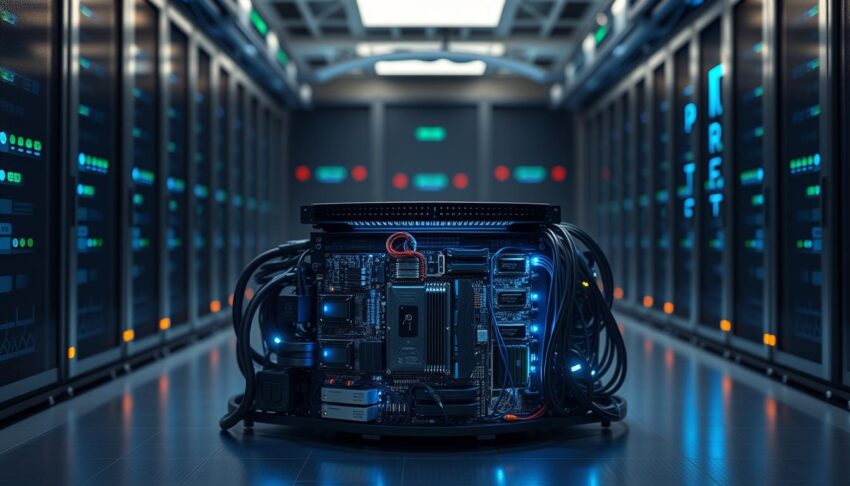Ever wonder how AI gets so smart? It's not just about smart ideas. It's also about the AI hardware that makes it work. We'll look at the key parts of machine learning hardware that boost performance and make deep learning better.
Keeping up with new artificial intelligence hardware is key. It helps us use AI to its fullest. Let's explore the world of AI hardware together. We'll see why choosing the right hardware is more important than ever for top AI results.
Key Takeaways
- Understanding the importance of AI hardware in implementing effective AI solutions.
- The role of hardware in the performance of machine learning applications.
- How staying updated on hardware trends enhances AI capabilities.
- The foundational components necessary for deep learning success.
- Insights into the evolving landscape of artificial intelligence hardware.
Introduction to AI Hardware
AI hardware is the stuff needed to make artificial intelligence work. It has special parts made for handling big data and running complex algorithms. Without the right parts, AI systems don't work well.
What is AI Hardware?
AI hardware includes many devices for artificial intelligence. You'll find graphical processing units (GPUs), central processing units (CPUs), and special AI accelerators. Each one helps make AI faster and more efficient.
The Importance of Hardware in AI
Hardware is key for AI to work well. Good hardware makes AI faster and more detailed. This helps AI get better and bring new ideas to industries.
Key Components of AI Hardware
Knowing the main parts of AI hardware is key for top performance. Processors, accelerators, and memory are the core of AI systems. Each part has special skills that boost deep learning hardware's power.
The need for better AI solutions is growing fast. This is why AI chips were created. They help with data and make things run smoother.
Processors and Accelerators Explained
Processors are the main workers in AI tasks. They can handle many things but struggle with big data and complex tasks. This is why GPUs were made.
GPUs are great at doing lots of things at once. They're perfect for AI tasks. AI chips, like TPUs, make things even better. They're made just for certain jobs.
Memory and Storage Considerations
Memory and storage are very important for AI hardware. Fast memory helps get data quickly. This is key for AI models that work with lots of info.
Memory needs to be fast and not slow. Storage also matters a lot. It needs to hold lots of data and get it fast. This helps AI chips do their best work.

Types of AI Chips
There are many kinds of AI chips out there. Each one is made for different tasks. Knowing the difference between CPUs and GPUs is key for those who use these chips.
CPU vs. GPU: Which is Better for AI?
CPUs are found in most computers. They are good at making complex decisions. GPUs, on the other hand, are great at handling lots of data at once.
When choosing between CPUs and GPUs, it depends on what you need:
| Criteria | CPU | GPU |
|---|---|---|
| Performance | Best for single-threaded tasks | Superior for parallel tasks |
| Cost | Generally lower cost | Higher investment for optimal performance |
| Speed | Slower with large datasets | Fast with large-scale computations |
| Use Cases | General-purpose computing | Deep learning, image processing |
TPUs and FPGAs: Specialized AI Processing Units
TPUs and FPGAs are at the top of AI chip technology. TPUs, made by Google, are super powerful for neural networks. They make deep learning faster and use less energy.
FPGAs are flexible because you can change them for different tasks. They are used in finance and healthcare for quick data work.
Neural Network Hardware Architectures
Neural networks need a lot of power to work well. They rely on special hardware to run smoothly. Knowing what hardware each network needs helps make them better.
There are many types of networks, like CNNs and RNNs. Each one needs different things from its hardware. This means we need to keep improving our machine learning tools.
Understanding Neural Networks and Their Hardware Needs
Each network type needs different things from its hardware. CNNs are great for pictures and need lots of speed. RNNs work with words and need good memory to keep track of things.
The right hardware is key for these networks to learn and get better.
Popular Architectures and Their Use Cases
Some networks are more popular than others for certain jobs. They work best with specific hardware:
| Architecture | Use Case | Hardware Requirements |
|---|---|---|
| Convolutional Neural Network (CNN) | Image Recognition | High throughput GPUs with optimized memory bandwidth |
| Recurrent Neural Network (RNN) | Natural Language Processing | High memory capacity and efficient data handling |
| Generative Adversarial Network (GAN) | Image Generation | Multi-GPU setups for parallel processing |
| Transformer Networks | Language Translation | Powerful tensor processing units (TPUs) for fast computation |

Using the right hardware lets us use these networks for their best jobs. This makes them work better and use resources well.
Deep Learning Hardware Essentials
Deep learning needs strong AI hardware to learn fast and process data well. GPUs are key because they can do lots of things at once. This helps a lot in training deep learning models.
The Role of GPUs in Deep Learning
GPUs are very important for deep learning. They have lots of cores that work together. This makes training models much faster than CPUs.
NVIDIA and others make special GPUs for deep learning. These GPUs are fast and efficient.
Key Features of Deep Learning Hardware
Deep learning hardware has important features:
- Computational Speed: Fast processing means models train quicker.
- Memory Bandwidth: Good memory bandwidth means data moves faster.
- Compatibility: Top frameworks like TensorFlow work well with many hardware setups.
Choosing the best deep learning hardware is key. It makes AI apps work better and grow. It's important for companies to improve their AI skills.
AI Processors for Machine Learning
AI processors are changing the tech world fast. They are made just for machine learning tasks. These processors work way better than old computers.
They can handle lots of data at once. This makes them super fast. They also don't get too hot, so they last longer.
They use less power too. This means they cost less to run.
How AI Processors Improve Performance
AI processors make things faster in many ways. They can run complex tasks quickly. This is great for learning and using data fast.
They have special memory and designs. This helps them deal with big data better. Companies like NVIDIA and Google make these processors work well for many tasks.
Comparing Different AI Processors
| Processor Model | Architecture Type | Peak Performance (TFLOPS) | Power Consumption (Watts) | Best-Suited Applications |
|---|---|---|---|---|
| NVIDIA A100 | GPU | 20 | 300 | Deep Learning, High-Performance Computing |
| Google TPU v4 | TPU | 275 | 200 | Large-scale Machine Learning |
| Xilinx Versal | FPGA | 50 | 70 | Adaptive Computing and Real-time Processing |
Each AI processor is special for different needs. Knowing this helps pick the right one for your job.
Choosing the Right AI Hardware for Your Applications
Choosing the right AI hardware is very important. It can make or break a project. You need to think about what you need, how much you can spend, and if it will grow with your project.
Factors to Consider When Selecting AI Hardware
When looking at AI hardware, remember these points:
- Performance Needs: Know how much your machine learning tasks need to compute.
- Cost Efficiency: Look at the cost now and later, including energy and upkeep.
- Scalability: Pick hardware that can grow with your project.
- Compatibility: Make sure it works well with what you already have.
Bespoke Solutions vs. Off-the-Shelf Hardware
Choosing between custom and standard hardware has its pros and cons:
- Bespoke Solutions: They fit your needs perfectly but cost more and take longer.
- Off-the-Shelf Hardware: It's cheaper and quicker but might not be as efficient.
Real examples show how picking the right hardware matters. A financial firm used custom GPUs for fraud detection, improving speed and accuracy. A retail company used standard hardware for recommendations, saving money.
Trends in AI Hardware Development
The world of AI hardware is changing fast. New technologies are making machine learning and artificial intelligence better. Companies are making special chips to help AI work faster and use less energy.
They are also making chips that can do complex AI tasks quickly and accurately. This is thanks to new ways of making chips.
Emerging Technologies in AI Hardware
New ideas in AI hardware include neuromorphic computing. It tries to work like the human brain for better processing. This could lead to big changes in AI.
As these new technologies grow, companies are spending a lot on research. They want to use these technologies to stay ahead in AI.
The Impact of Quantum Computing on AI
Quantum computing could change AI hardware a lot. It uses quantum mechanics to make processing faster and more powerful. This means AI can do more complex tasks.
As quantum tech gets better, it could change how AI works. It could make things possible that we can't do now. It's important for AI experts to keep up with these changes.
